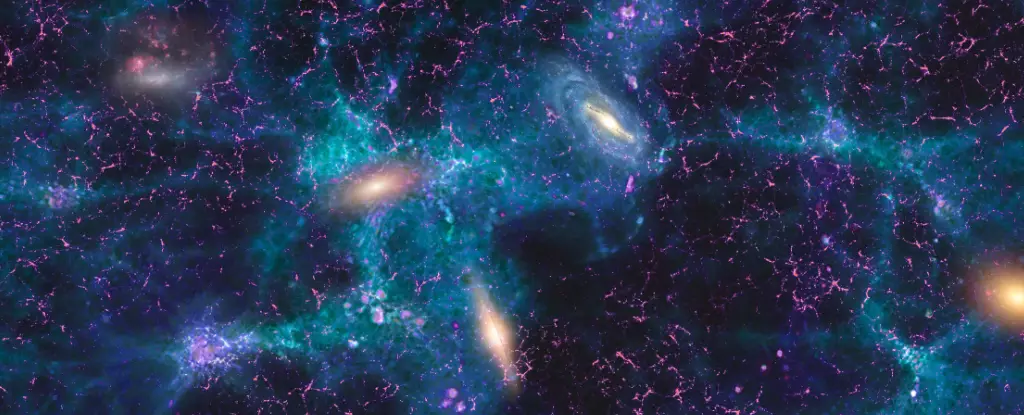For decades, astronomers have been piecing together the grand puzzle of our universe’s expansion. This relentless spread of galaxies across an increasingly empty cosmos presents opportunities and challenges to our current understanding of physics. Recent research, notably through careful analysis of the Coma galaxy cluster, has brought to light inconsistencies in how we measure the universe’s growth. Despite our advancements, the mechanics of cosmic expansion remain shrouded in enigmatic mechanisms, including inflationary quantum fields and elusive dark energy—the latter being responsible for the accelerated expansion of our universe.
The cosmic fabric weaves an intricate story, where clumps of matter float within a vast, dark void. The prevailing model, pinned down by the Hubble constant, theorizes that space itself is stretching, propelling galaxies away from one another at a predictable rate. It paints a picture of a universe in motion, yet it is a canvas marred by discrepancies that question our models.
In the realm of cosmology, a peculiar tension has emerged that challenges established measurements of cosmic expansion. The Hubble constant, which lays the foundation for understanding the rate of expansion, is yielding conflicting results depending on the method of measurement employed. Dan Scolnic, a physicist from Duke University, has been at the forefront of this critical scrutiny. His team’s meticulous analysis of the Coma cluster—a collection of over 1,000 galaxies approximately 320 million light-years away—aims to reconcile these disparate measurements.
Different observational techniques yield alarmingly varied results regarding the rate of expansion. On one hand, proximity measurements, such as Scolnic’s recent research, indicate an expansion velocity of 76.5 kilometers per second per megaparsec. Conversely, observations rooted in ancient cosmic microwave background radiation suggest a much slower rate of 67.4 kilometers per second per megaparsec. This stark division reveals what Scolnic describes as a “crisis” in our understanding.
Decoding the Cosmic Ladder
Analyzing these measurements involves constructing a meticulous “ladder” that connects local and distant observations through a series of increasingly comprehensive steps. Scolnic’s team capitalized on the Dark Energy Spectroscopic Instrument’s findings to provide essential data points linking vital distances across cosmic scales. The work of the DESI collaboration, which laid the groundwork for calculating distances to the void between galaxies, essentially provided the foundational rungs of this ladder. However, without further precision, establishing a trustworthy framework for cosmic measurements remains an uphill battle.
The cosmic distances are often anchored by certain standard candles, specifically Type Ia supernovae, whose consistent light patterns serve as dependable beacons for measuring astronomical distances. Scolnic’s analysis identified how these stellar phenomena can refine observations, confirming distance estimates for the Coma cluster. This critical validation not only underpins local measurements but also enhances our understanding of the wider cosmic expansion.
Where Do We Go From Here?
The central question has shifted from “How is the universe expanding?” to “Why are our measurements so different?” This disparate findings prompt researchers to delve deeper into refining cosmic measurements or possibly reevaluating fundamental assumptions underlying our models. The implications could lead to groundbreaking insights—or potentially revolutionize our understanding of physics in the universe altogether.
As Scolnic points out, we are at a critical juncture where the assumptions of cosmological models that have served us well for the past 25 years are increasingly under scrutiny. The acknowledgment of conflicting measurements is not merely a disheartening setback; it is an invitation to explore new dimensions of physics that may redefine our comprehension of cosmological expansion and the universe’s very fabric.
This conflict in measuring cosmic expansion indicates that there may be physics beyond our current grasp—unexplored territories of the universe waiting to be dissected. We are navigating a challenging yet exhilarating time in modern cosmology. The hopes are twofold: either we will uncover critical miscalculations in our current framework, or we will unveil new laws of physics that fundamentally reshape how we perceive the universe. The quest to decode this cosmic conundrum is not merely scientific; it is an endeavor that could illuminate aspects of reality that we’ve yet to fathom.
As we embark on this intricate quest, astronomers are poised to make discoveries that could redefine our understanding of the cosmos. With each measurement and analysis, we step closer to potentially unraveling the mysteries that lie beyond the stars, driven by an insatiable curiosity that fuels human exploration into the infinite unknown.

